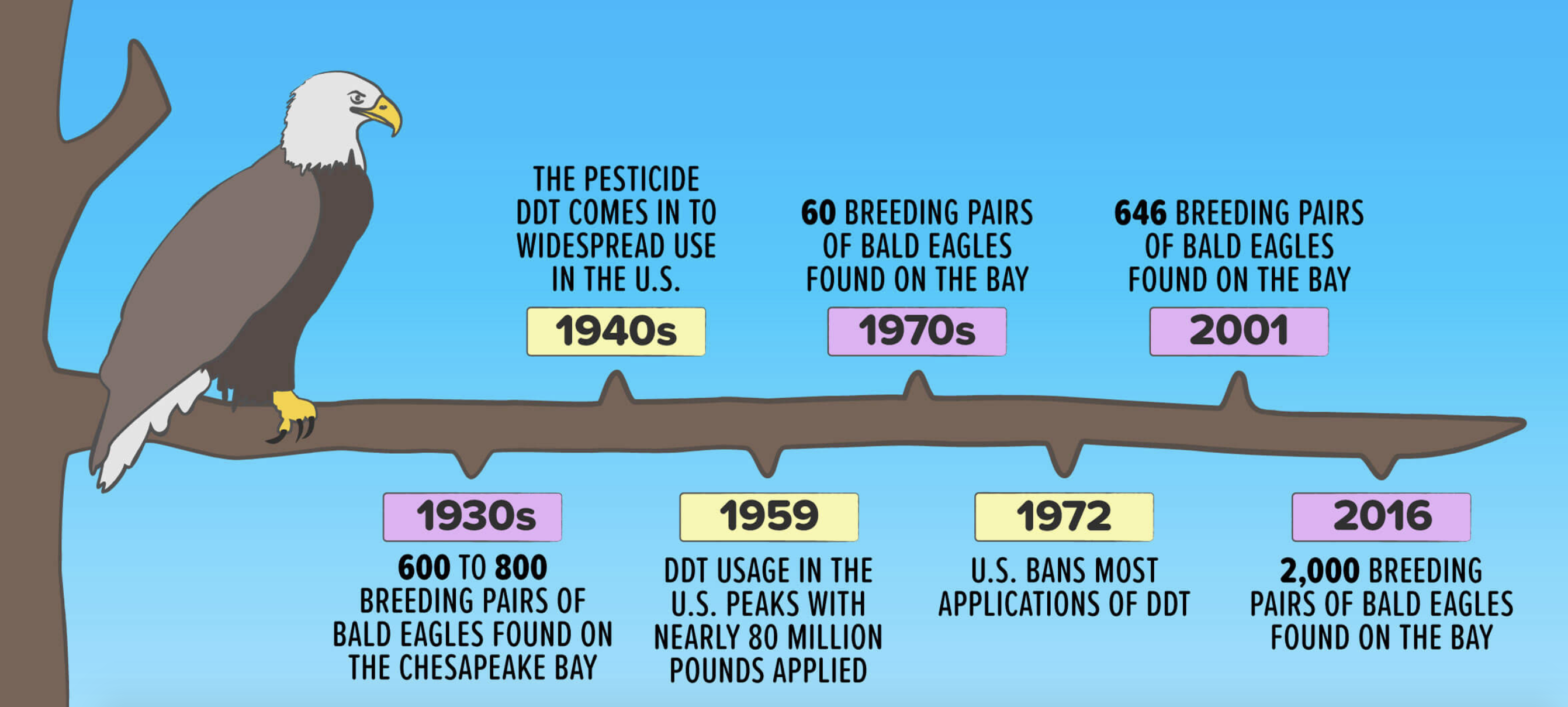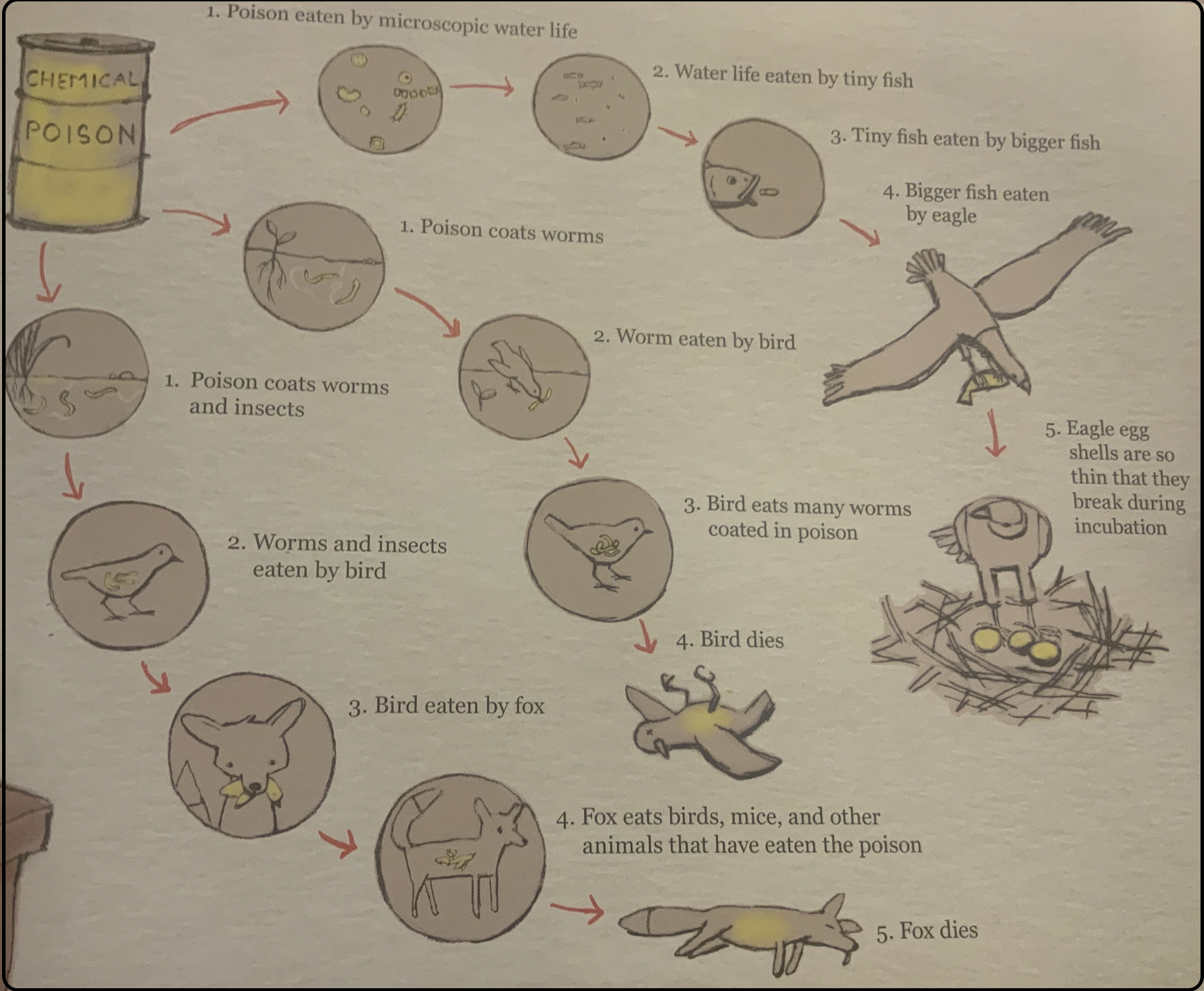Rachel Carson: Catalyst of the Environmental Movement


NATURE IS OUT OF BALANCE
Air and water pollution enhanced by chemical sprays had huge impacts on wildlife. Chemicals in the water affected the fish eaten by the birds of prey that could not reproduce, and numbers declined. The Rachel Carson Society website noted:
"Eagles were also disappearing. By 1963, only 417 pairs were still raising young in the lower 48 states.”

"Bald Eagles" Chart from US Environmental Protection Agency Chesapeake Bay Program website, April 2020
"Shortly after World War II, DDT was hailed as a new pesticide to control mosquitoes and other insects. However, DDT and its residues washed into nearby waterways, where aquatic plants and fish absorbed it. Bald eagles, in turn, were poisoned with DDT when they ate the contaminated fish. The chemical interfered with the ability of the birds to produce strong eggshells. As a result, their eggs had shells so thin that they often broke during incubation or otherwise failed to hatch. DDT also affected other species such as peregrine falcons and brown pelicans."
~ US Fish and Wildlife Service June 2007 Brochure on "Bald Eagle"

Stephanie Roth Sisson, DDT Food Chain impacts, 2018, p.23
By 1947, enough concern caused a new law to be passed a law requiring chemicals to be registered and for insecticides to include labels.
"In the late 1940s, the federal government responded to the conflicting potentials for good and evil of pesticides by enacting one of the earliest and long-lasting regulatory laws. It was known as FIFRA, the Federal Insecticide, Fungicide and Rodenticide Act of 1947...Largely out of the public eye, farm groups, the manufacturers and the USDA began working with Congress to write a new pesticides law. What the four participants came up with was a bill to require pesticide manufacturers to register their chemicals with the USDA and provide label information about the contents, directions for use and antidotes if the chemical was ingested by humans. The stated objective was to protect 'the users of economic poisons [farmers and] the reputable manufacturer or distributor from those few opportunists who would discredit the industry.'"
~ Bill Ganzel, Pesticide Regulations-FIFRA, Farming in the 1940s, accessed April 2020
The new laws did not protect the environment or the public from the harmful affects of widespread use of chemicals for pest-control.
"Nothing was said in the FIFRA legislation about protecting the public or the environment from long-term exposure to pesticides. In part, the reason nothing was said was that not much was known about long-term or low level exposure. There had been a few warnings. In 1944, researchers at the U.S. Public Health Service warned, 'The toxicity of DDT combined with its cumulative actions and absorbability through the skin places a definite health hazard in its use.' Some USDA studies had seen the destruction of 'beneficial' insects and wildlife along with the destruction of the target insect. And the FDA had quietly considered holding DDT off the market to study it further. But the no one knew enough about the potential harm from DDT or other pesticides to overcome the good that was being demonstrated every day."
~ Bill Ganzel, Pesticide Regulations-FIFRA, Farming in the 1940s, accessed April 2020
CLICK PLAY TO WATCH VIDEO OF RACHEL CARSON
Excerpt from David Wisnieski's “Pollution and the Environmental Movement," Benefits and Risks of the Pesticide DDT, American Masters—A Fierce Green Fire, WNET Education, 2015.
Rachel Carson studied the impacts on the environment, living organisms, and humans. According to Robert Musil, President and CEO of the Rachel Carson Council, Carson was the first well-known scientist who had linked the environmental effects to humans. Carson reported that 1960 figures from the National Office of Vital Statistics showed rising cases of leukemia.
"Dr. Malcolm Hargraves and his associates in the Hematology Department at the Mayo Clinic report that almost without exception these patients have had a history of exposure to various toxic chemicals, including sprays which contain DDT, chloradane, benzene, lindane, and petroleum distallates. Environmental diseases related to the use of various toxic substances have been increasing, 'particularly during the past ten years,' Dr. Hargraves believes. From extensive clinical experience he believes that 'the vast majority of patients suffering from the blood dyscrasias and lymphoid diseases have a significant history of exposure to the various hydrocarbons which in turn includes most of the pesticides of today. A careful medical history will almost invariably establish such a relationship.'"
~ Rachel Carson,"One in Every Four," Silent Spring, p. 227, 1962